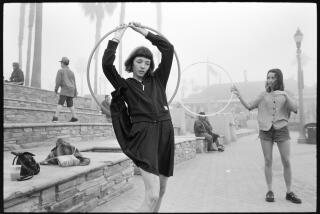California Journal: Hugh Hefner preached sexual liberation, but he never stopped exploiting women’s bodies
- Share via
Years ago, I pulled into a long driveway in Holmby Hills, then stopped in front of an imposing wrought-iron gate. I had been directed to announce myself to a large boulder on my left, which I did. The gates swung open.
Suddenly, I was outside the storied Playboy Mansion, a beautiful stone chateau that had become synonymous with orgiastic bacchanals (is that redundant?) tossed by its owner, Hugh Hefner, who died Wednesday at 91. Those parties — decorated by scantily clad young women — were rites of passage for scores of horny Hollywood types and professional athletes.
As I parked, I realized something was not quite right. A bright plastic baby swing hung from a graceful tree near the mansion’s imposing front door. Children’s toys were scattered about. Hefner was married — to Kimberly Conrad, a former Playmate of the Year. Their son, Marston, was a toddler.
People magazine had treated their 1989 marriage as a modern-day miracle: “Next week, Hell freezes over,” it declared.
After Hefner’s brief foray into domesticity, he reverted to his former sexual libertinism. He was frequently photographed with an evolving trio of buxom blonde young women. I’m sure there’s nothing sexier than being treated interchangeably by a man who has got at least half a century on you.
Hefner married again, in 2012, to a woman 60 years his junior, who has now become his widow.
Anyway, I’d come to the mansion to interview Wendy Hamilton, a 23-year-old from Detroit who had been selected to be Playboy magazine’s Miss December 1991. I was told by the magazine people that I was the first reporter they’d ever allowed to witness a centerfold shoot, which I had done some days earlier in the studios of the Playboy building on Sunset Boulevard.
It was the least sexy photo shoot I’d ever seen, but it was the culmination of a girlhood dream for Hamilton. When she was 10, she saw her father’s Playboy centerfold calendar in the garage and solemnly told him, “One day, Daddy, I am gonna be one of those girls.”
Who knows how many other little girls were infected by the idea that taking off their clothes for men would be the pinnacle of achievement?
::
Above all, Hugh Hefner was in the fantasy business.
Men’s fantasies, for sure. But women’s fantasies, too. Not their sexual fantasies, mind you. Their fantasies about male attention, self-esteem and success.
It is an enduring irony to me that Hefner, who pushed what he called a “wholesome” version of female sexuality in the pages of his magazine (pretty faces, big boobs, no pubes), probably did more to mainstream the exploitation of women’s bodies than any other figure in American history.
Really, he managed one of the greatest cons of all time: In the decades that American women were liberating themselves at home and in the workplace — and actually forcing the creation of new legal concepts like sexual harassment and date rape — he managed to convince many women that taking off their clothes for men’s pleasure was not just empowering, but a worthy goal in itself. The deception was also extremely profitable; Hefner became a multimillionaire along the way.
He did not coin the phrase “the male gaze” (credit for that goes to a feminist film critic) but he certainly embodied the aesthetic notion that images of women — and women themselves — exist to please men.
“Playboy,” he once said, “treats women — and men, too, for that matter — as sexual beings, not as sexual objects. In this sense, I think Playboy has been an effective force in the cause of female emancipation.”
That is denial of the highest order. Had he been truly committed to “female emancipation,” he would have embraced the idea that women, not just men, can be sexual their entire lives.
Instead, as you can see from his marriage, his dating history and the pages of his magazine, women have a well-defined shelf life.
After, say the age of 30, they not only expire, but also cease to exist, naked or otherwise.
::
The pajama-clad, pipe-smoking Hefner will remain a paradoxical figure in American culture.
His magazine was a repository of smart journalism. And in years past, the Playboy Foundation supported organizations devoted to laudable goals like reproductive rights and civil liberties.
Certainly, Hefner waged a much-needed battle against the forces of 20th century American puritanism, but sadly, in a way that liberated men (or at least their masturbatory fantasies) by objectifying women.
Eventually, as was bound to happen, the culture passed Playboy by.
The internet and the cellphone conspired to make Playboy-style nudity quaint. In 2015, the magazine announced it would no longer publish fully naked photographs of women, just suggestive ones. By that point, who even cared?
Playboy’s effect on the way young women are viewed and treated is irrevocably ingrained in the culture. Look no further than the grabby occupant of the Oval Office.
I wanted to get a male perspective on Hefner’s passing, so I walked over to my father’s house. At 88, he’s a retired Cal State Northridge English professor and a guy who became something of a swinging single himself after my parents divorced in the late 1970s.
“What did you think of him, Dad?” I asked.
My father leaned back in his chair and looked at the ceiling for a moment. “Well,” he said, “he really was a sexist.”
Well said, Pops.
To read the article in Spanish, click here
Twitter: @AbcarianLAT
ALSO



